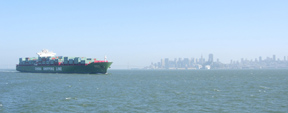The U.S. Department of Commerce last month approved the Port of San Francisco’s application to expand its Foreign Trade Zone (FTZ) No. 3 service area to include Contra Costa, Marin and Solano Counties, as well as portions of Sonoma and Napa Counties.

The U.S. Department of Commerce last month approved the Port of San Francisco’s application to expand its Foreign Trade Zone (FTZ) No. 3 service area to include Contra Costa, Marin and Solano Counties, as well as portions of Sonoma and Napa Counties. Photo by Joel Williams
By Patrick Burnson
Published: June, 2013
The U.S. Department of Commerce last month approved the Port of San Francisco’s application to expand its Foreign Trade Zone (FTZ) No. 3 service area to include Contra Costa, Marin and Solano Counties, as well as portions of Sonoma and Napa Counties. The previous service area included San Francisco and San Mateo Counties. This action will support efforts to strengthen the local economy and attract new businesses to the area.
A Foreign Trade Zone site is a secured area near a designated customs port of entry, and while physically located within the U.S. it is considered outside the U.S. Customs territory. This allows for foreign goods to be brought into FTZs without formal customs entry for manufacturing, testing, assembly, processing, storage and distribution. Duty payments on imported goods and materials can be deferred until they leave the designated area and enter U.S. commerce. Goods not entering U.S. commerce—for example, re-exports or scrap—are not obligated to pay customs duties. The FTZ program allows American companies to obtain a more competitive position with respect to their counterparts overseas, and subsidizes job growth by reducing customs duties.
"Foreign Trade Zones are one tool to reduce logistics costs, which translates into savings to a company’s bottom line," said Jim Maloney, maritime marketing manager at the Port of San Francisco. "The FTZ program provides an excellent opportunity for Bay Area businesses to enhance their competitiveness in the global economy."
The program allows existing and new companies in these counties to secure FTZ site status under the streamlined Alternative Site Framework program within approximately 30 days from when an application is accepted. Without the program, the process can take 8-12 months.
There will be no additional requirements of the new counties and cities covered by the program. It is an opt-in incentive, managed jointly by the Port of San Francisco, the U.S. Department of Commerce and U.S. Customs and Border Protection, with companies electing whether or not to participate.
In order to participate in the program, interested businesses will apply through Foreign Trade Zone No. 3. Applications can be found on the U.S. Foreign-Trade Zones Board website at http://ia.ita.doc.gov/ftzpage/. After the application is approved, companies can be eligible for the following benefits:
• Duty Deferral: Duties are paid on goods only as they leave the FTZ to be sold, improving cash flow.
• Duty Reduction: Items can be packaged, manufactured or used as part of another product. If a lower duty applies to the finished product, only that amount is paid.
• Duty Elimination: If a product is re-exported, or sold to the military, no duty is paid. Likewise, documented waste or faulty product incurs no duty charge.
• Weekly entry of imported shipments, rather than "per-shipment" entry, allows for substantial savings on processing fees.
• No duty is paid on domestic content or value added to a product, including the cost of labor, use of domestic parts, overhead and profit. Final duties are assessed on the value of foreign content only.
Major Shipping Industry Conference Coming in June
A major upcoming shipping industry conference in San Francisco will provide yet more information on West Coast opportunities for bulk and breakbulk exporters, as well as those moving goods by containerload when the Agriculture Transportation Coalition (AgTC) convenes its 25th annual meeting June 13-14 at the Hotel Nikko.
The event gets underway when attendees board the historic Presidential yacht Potomac for an afternoon cruise and reception on San Francisco Bay, hosted by the Port of Oakland. Then, one of the most anticipated sessions is certain to be "U.S. Ag Export Outlook—What Comes Next?" by Walter Kemmsies, chief economist with Moffatt & Nichol.
The annual dinner will feature "The State of the AgTC," a fast-paced and often irreverent overview of the state of ag and forest products transportation and export, with predictions for the coming year. According to Executive Director Peter Friedmann, this talk will cover "sequestration, port labor, who is doing their job, and who isn’t, whose cargo is getting rolled, rate increases—how the government is hampering exports."
Another conference highlight will be presentation of the Seventh Annual Ocean Carrier Performance Survey Results & Award. This is the primary benchmark by which carriers can determine how they are perceived by agriculture shipper customers. For more information, see www.agtrans.org.

